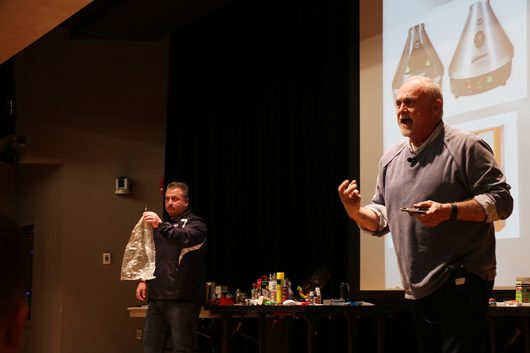
Capt. Shawn Bain (left) and Sgt. Michael Powell of the Franklin County Sheriff’s Office discuss drug misuse and other drug related topics. Credit: Deepti Hossain | Senior Lantern reporter
From the streets to informational sessions across Ohio, the “Operation Street Smart” presentation — hosted most recently on Wednesday at the College of Social Work by the Franklin County Sheriff’s Office — has discussed drug misuse, concealment techniques and terminology.
“The street drugs are out there. There’s always something new, there’s always something different,” said Lisa Durham, the College of Social Work’s assistant dean of strategic initiatives and community engagement. “We wanted to expand the opportunity for people to learn about what’s really going on in the world.”
Ohio leads the nation in opiate deaths, according to multiple studies, and Sgt. Michael Powell said drug misuse can be especially pertinent on college campuses. According to the College Prescription Drug Study headed by the Higher Education Center for Alcohol and Drug Misuse Prevention and Recovery and the Center for the Study of Student Life, 44 percent of undergraduate students said that it is easy to get sedatives. A little less than three-fourths of undergraduates say it is easy to obtain stimulants.
Powell and Capt. Shawn Bain aimed to teach attendees what undercover officers see on the streets to prevent future drug misuse.
“The primary goal is to lay the foundation, for anybody attending, on what to be looking for,” Powell said. “We give them little indicators of things that they see in (the) everyday world that could lead them to someone abusing some type of drug in their world.”
During the presentation, Powell and Bain displayed various types of paraphernalia people use everyday to carry, conceal or abuse a drug.
For example, a chapstick container. Drug misusers remove some of the chapstick, put the pill in, and pop the top back on. People often use a Pringles can with a false bottom to hide drugs. Bain also showed attendees what looked like a normal peanut butter and jelly sandwich, but was instead a zippered case that could hide drugs; it costs $35.
Joni Sivey, a master’s student in the College of Social Work with an interest in studying substance abuse, said the presentation was a good review for her.
“It’s always a reminder to look at kids who you don’t think are using. We always look at kids who are in trouble,” Sivey said. “Sometimes kids don’t use because they’re bad, but because they want to use to socialize.”
Lori Povisil, Safe and Drug Free Schools coordinator at Worthington City Schools said she attended this session to keep up with the trends in drug misuses.
“We have students who make poor choices and sometimes bring drugs and paraphernalia to school,” Povisil said. “If we’re doing a backpack search, or locker search or if we’re asking them to empty their pockets, we need to know what we’re looking at, so we’re educated in the latest ways to hide things.”
Powell and Bain also explained how to detect deception through body language and certain vocabulary. Povisil said she found this especially helpful.
“I think it’s critical to be able to take (this) back to the parents in our district, and to our staff and our teachers,the deception and how to be able to navigate the truth.” Povisil said. “When is a kid telling the truth versus when is a student lying?”
The Operation Street Smart program started in 2002 and has since completed 2,000 sessions and is funded by Franklin County, as well as the Ohio High Intensity Drug Trafficking Area program.
“(We) live in a drug-taking culture,” said Ken Hale, associate director of the Higher Education Center for Alcohol and Drug Misuse Prevention and Recovery. “On campuses, the average age where prescription-drug misuse starts is in the low 20s. I believe that we have strong responsibility like places on Ohio State’s campus to help educate students around the realities of this issue.”
Hale added that Ohio had the highest number of people who died of drug overdose last year: 3,050.
“They expect that number will double this year,” Hale said. “We know that the behavior that typically leads to that starts about the age where most of our students are.”


